Explore the essentials of wheel and axle dynamics, focusing on efficiency, load handling, motion, and their impact on mechanical engineering.

Understanding Wheel and Axle Dynamics: An Overview
Wheel and axle dynamics play a crucial role in mechanical engineering and automotive design, influencing the efficiency, load handling, and motion of various machines and vehicles. This article delves into the core principles that govern these dynamics, shedding light on how they impact the performance and functionality of mechanical systems.
Efficiency of Wheel and Axle Systems
The efficiency of a wheel and axle system is primarily determined by its ability to convert input energy into useful work. It involves factors such as friction, mechanical advantage, and energy losses. The mechanical advantage (MA) of a wheel and axle is expressed as the ratio of the radius of the wheel (rw) to the radius of the axle (ra): MA = rw/ra. A higher MA implies greater efficiency, as less force is required to move a load.
Load Handling in Wheel and Axle Systems
Load handling refers to the capacity of a wheel and axle system to support and transport weight. It is crucial for the stability and safety of vehicles and machinery. The load capacity depends on factors like material strength, wheel size, and axle diameter. The distribution of load between the wheel and axle must be optimal to minimize stress and wear.
Motion Dynamics in Wheel and Axle Systems
Motion dynamics in wheel and axle systems are influenced by factors like torque, rotational speed, and angular momentum. Torque (τ) is the rotational equivalent of linear force and is calculated as τ = r × F, where r is the radius, and F is the force applied perpendicular to the radius. The interplay between torque and wheel radius affects acceleration, deceleration, and overall vehicular control.
Understanding these principles is essential for designing efficient and reliable mechanical systems. In the following section, we will delve deeper into the applications and implications of wheel and axle dynamics in real-world scenarios, exploring how these principles are applied in various industries and innovations.
Applications of Wheel and Axle Dynamics
The principles of wheel and axle dynamics find applications in numerous fields, ranging from simple machines to complex automotive systems. In transportation, optimizing wheel and axle dimensions can significantly improve vehicle performance, enhancing fuel efficiency and maneuverability. In industrial machinery, these dynamics are essential for designing systems that can handle heavy loads while maintaining operational efficiency.
Impact of Wheel and Axle Dynamics on Innovation
Innovations in wheel and axle design have led to advancements in various technologies. For example, in high-speed trains, the wheel and axle configurations are designed to minimize friction and wear, allowing for faster and smoother travel. Similarly, in renewable energy, wind turbines utilize these principles to maximize energy generation efficiency.
Challenges and Future Directions
Despite the advancements, challenges remain in optimizing wheel and axle systems for different applications. Material limitations, environmental factors, and the ever-increasing demand for sustainability pose significant challenges. Future developments in materials science and engineering could lead to more durable and efficient wheel and axle designs, contributing to greener and more sustainable technologies.
Conclusion
Wheel and axle dynamics are fundamental to the field of mechanical engineering, playing a pivotal role in the efficiency, load handling, and motion of various systems. The balance between efficiency, load capacity, and motion dynamics is crucial for the optimal design of these systems. As technology advances, the principles of wheel and axle dynamics will continue to be a cornerstone in the development of innovative and sustainable solutions in transportation, industry, and renewable energy. The ongoing research and development in this area promise to bring forth even more efficient, reliable, and environmentally friendly applications, driving progress across multiple sectors.
